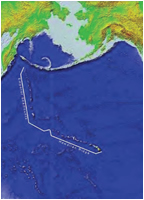The Geology of Papahānaumokuākea
 Beginning 250 kilometers northwest of the main Hawaiian Island of Ni‘ihau, the ten islands and atolls of this Pacific chain extend for 1,931 kilometers. None of the included islands is more than five square kilometers in size, and all but four have an average mean height less than ten meters above sea level. As a group, these islands represent a classic geomorphological sequence, consisting of highly eroded high islands, near-atolls with volcanic pinnacles jutting from surrounding lagoons, true ring-shaped atolls with roughly circular rims and central lagoons, and secondarily raised atolls, one of which has an interior hypersaline lake. In addition, more than 30 submerged ancillary banks and seamounts have been discovered around these islands. The geological progression along the Hawaiian Ridge continues northwestward beyond the last emergent island, Kure Atoll, as a chain of submerged platforms that makes a sudden northward bend to become the Emperor Seamounts, which extend across the entire North Pacific to the base of the Kamchatka Peninsula in Russia. This unbroken chain of progressively more senescent volcanic structures essentially tracks the movement of the Pacific tectonic plate over the past 80 million years, and has provided some of soundest evidence upon which current theories of hotspot-mediated island formation and global plate tectonic movements have been based. Formed millions of years ago, these islands were created by a deep-sea volcanic “hotspot” now located south of the island of Hawai‘i, which formed a sequential series of underwater shield volcanoes that became islands as they rose above the ocean’s surface. These once-lofty islands have been transported northwest by the movements of the Pacific Plate to their current locations (Dalrymple et al. 1974). Due to the pervasive and unrelenting forces of subsidence and erosion, all that remains today are small patches of ancient land, shoals and reefs that lie where significant mountains once loomed. Nowhere else in the world is this progression illustrated in such an unambiguous and linear fashion. Papahānaumokuākea also includes a unique example of an atoll at the critical “Darwin Point,” the northernmost threshold for coral reef existence. Kure Atoll is the northernmost coral reef in the world, and has reached the latitude at which coral growth rates, which decrease in cooler temperatures, are matched by the rate of subsidence of the island.
Beginning 250 kilometers northwest of the main Hawaiian Island of Ni‘ihau, the ten islands and atolls of this Pacific chain extend for 1,931 kilometers. None of the included islands is more than five square kilometers in size, and all but four have an average mean height less than ten meters above sea level. As a group, these islands represent a classic geomorphological sequence, consisting of highly eroded high islands, near-atolls with volcanic pinnacles jutting from surrounding lagoons, true ring-shaped atolls with roughly circular rims and central lagoons, and secondarily raised atolls, one of which has an interior hypersaline lake. In addition, more than 30 submerged ancillary banks and seamounts have been discovered around these islands. The geological progression along the Hawaiian Ridge continues northwestward beyond the last emergent island, Kure Atoll, as a chain of submerged platforms that makes a sudden northward bend to become the Emperor Seamounts, which extend across the entire North Pacific to the base of the Kamchatka Peninsula in Russia. This unbroken chain of progressively more senescent volcanic structures essentially tracks the movement of the Pacific tectonic plate over the past 80 million years, and has provided some of soundest evidence upon which current theories of hotspot-mediated island formation and global plate tectonic movements have been based. Formed millions of years ago, these islands were created by a deep-sea volcanic “hotspot” now located south of the island of Hawai‘i, which formed a sequential series of underwater shield volcanoes that became islands as they rose above the ocean’s surface. These once-lofty islands have been transported northwest by the movements of the Pacific Plate to their current locations (Dalrymple et al. 1974). Due to the pervasive and unrelenting forces of subsidence and erosion, all that remains today are small patches of ancient land, shoals and reefs that lie where significant mountains once loomed. Nowhere else in the world is this progression illustrated in such an unambiguous and linear fashion. Papahānaumokuākea also includes a unique example of an atoll at the critical “Darwin Point,” the northernmost threshold for coral reef existence. Kure Atoll is the northernmost coral reef in the world, and has reached the latitude at which coral growth rates, which decrease in cooler temperatures, are matched by the rate of subsidence of the island.
